Kansas has cities, woodlands, rivers, state parks, agricultural lands, and so much more, making it the ideal place for numerous fascinating bird species. In fact, more than 470 different bird varieties have been found in Kansas. Found out more about many of these birds in our Kansas Bird Guide.
Of those 470 birds, 25 different sparrows routinely live in or visit Kansas.
This includes sparrows who come here for the summer breeding season, in the winter, or during migration and those more common birds who stick around all year.
Let’s take a look at these 25 kinds of sparrows, each with its own unique characteristics.
What Is a Sparrow?
Have you ever heard a bird called an “LBJ” or a “little brown job?” If so, the birds being referred to were sparrows.
They are called LBJs because they tend to look pretty similar to each other, especially from a distance or at a glance. These small, brown birds are somewhat difficult for bird watchers to identify. Although it’s easy enough to say, “Oh, that’s a sparrow,” there is definitely a challenge to figuring out which kind of sparrow you’re seeing.
Sparrows are usually between 5-7 inches long with brown coloring and black and tan streaks. They may have a little bit of additional color, typically yellow, orange, or rufous.
Their strong bills are short, sharp, and conical, as they use them to break into seeds and nuts. They also eat a diet that is rich in insects and bugs during the summer.
Sparrows are widespread throughout the US – and, in fact, the entire world. North American sparrows may be found on other continents after traveling there by ship.
How Many Sparrows Are in Kansas?
There are at least 25 kinds of sparrows that you can find in Kansas, although some are more populous than others. We are not including any rare migratory vagrants on our list, though. Instead, we are only looking at the sparrows that are predictably within Kansas’s borders at some point each year.
To make it as easy as possible, we have divided these sparrows into 4 categories based on when they are present in the state.
Identifying Sparrows
It’s not easy to identify sparrows! Distinguishing them from one another is a challenge for even the most experienced birders.
However, it’s not impossible, and with some attention to detail and careful observation, you can figure out which one is which.
Be sure to take note of the following while identifying sparrows in Kansas:
- What are the bird’s colors? (Face, neck, chest, belly, back, flanks, wings, tail)
- What kind of patterns do you see in their markings?
- What is their silhouette (or shape)?
- If they were eating when you saw them, what were they eating?
- What else were they doing?
- When did you see them?
- Where did you see them – as in, what kind of habitat were they in, and where in the state were you?
With this information, let’s get started!
Sparrows in Kansas All Year
There are three kinds of sparrows that stay in Kansas all year, including both the breeding and non-breeding seasons. These are the Field Sparrow, the House Sparrow, and the Rufous-Crowned Sparrow. If these little birds migrate at all, it’s not very far.
Field Sparrow
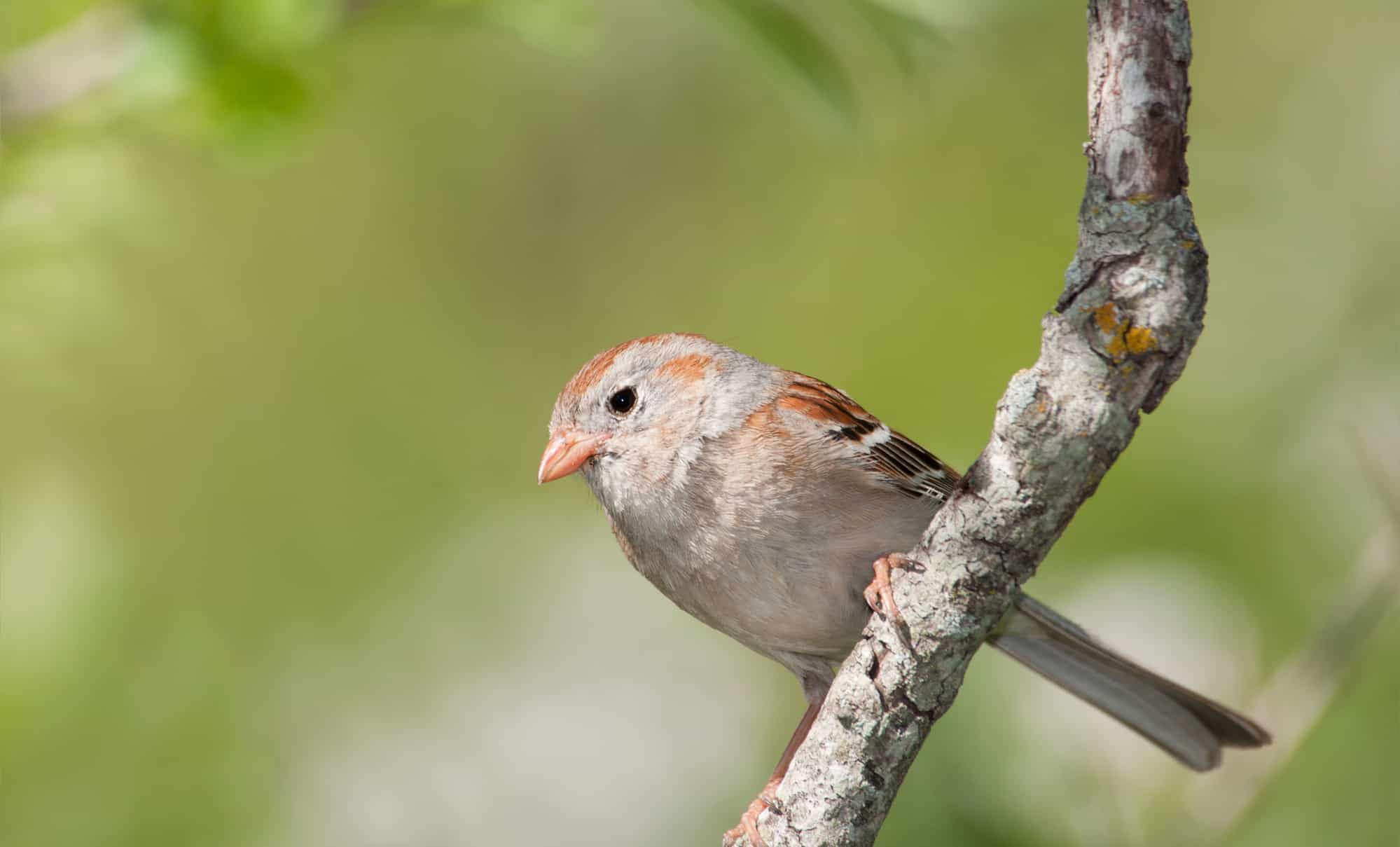
- Spizella pusilla
- ORDER: Passeriformes
- FAMILY: Passerellidae
- Length: 4.7-5.9 in (12-15 cm)
- Weight: 0.4-0.5 oz (11-15 g)
- Wingspan: 7.9 in (20 cm)
The first bird on our list is the Field Sparrow, a little bird that weighs only as much as an empty soda can.
Both male and female Field Sparrows are mostly gray-colored, with some brown streaks on their backs and wings. Their cap is rusty-brown, and they have a white ring around their eyes. The Field Sparrow’s bill is pink.
They prefer grassy fields and open land, rather than populated areas like cities and towns.
Imagine drawing a diagonal line through Kansas, starting at the southwest corner and moving up toward the northeast corner. Southeast of that line, Field Sparrows are year-round residents of Kansas. In the rest of the state, they are breeding-season-only birds.
They are experiencing a decline in their numbers due to suburban expansion and habitat loss.
Although Field Sparrows typically nest on the ground, they will build a nest higher in a bush or tree if their first nest is attacked by predators.
House Sparrow
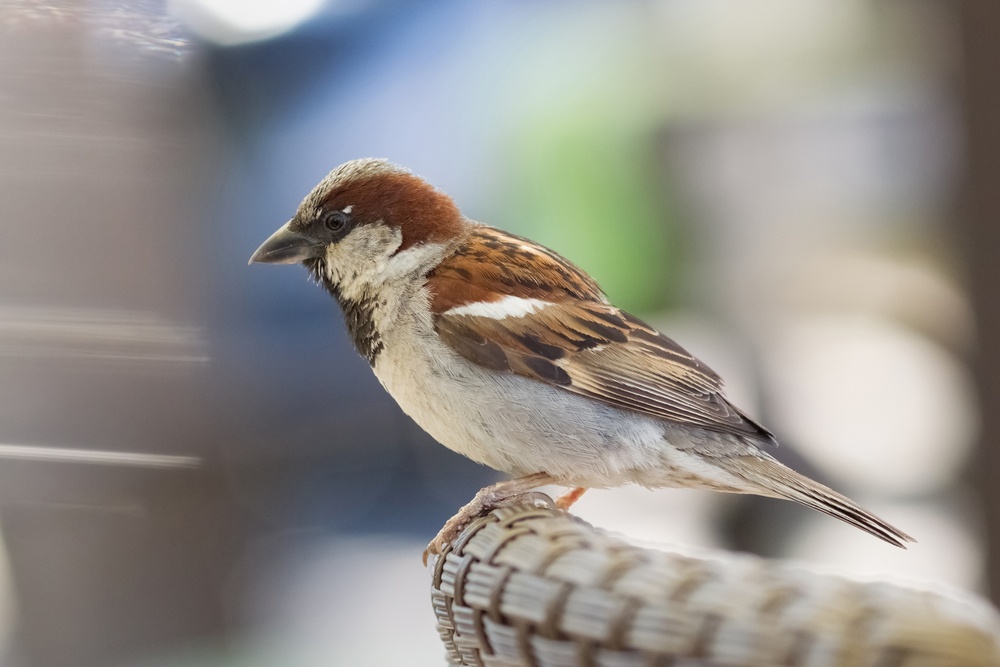
- Passer domesticus
- ORDER: Passeriformes
- FAMILY: Passeridae
- Length: 5.9-6.7 in (15-17 cm)
- Weight: 0.9-1.1 oz (27-30 g)
- Wingspan: 7.5-9.8 in (19-25 cm)
House Sparrows are an invasive species, and they have done very well in North America. So well, in fact, that they are a threat to many of the local, native birds whose habitats they have moved into. They will even kill these birds in competition for nesting spaces, territory, and food.
Male House Sparrows have a rufous neck, black bib, gray head, and white cheeks. Females are mostly brown with black stripes on their backs.
They live in cities, towns, and in the rafters of barns and buildings. They are widespread across all of the US, including Kansas. You will certainly find them in urban areas, but they also nest in isolated houses and businesses far from urban life.
Rufous-Crowned Sparrow

- Aimophila ruficeps
- ORDER: Passeriforme
- FAMILY: Passerellidae
- Length: 5.25 in (13.3 cm)
- Weight: 15- 23 g (0.53 – 0.81 oz)
- Wingspan: 7.75 in (19.68 cm)
Rufous-Crowned Sparrows are quite drab, but their light rufous cap does help them stand out from other LBJs. Their coloring is mostly gray with streaks on the back. A white eyering and white “whiskers” are their distinctive facial markings.
They are known for being fairly sedentary, usually hiding under thick vegetation. They will scurry around rather than fly. Males, however, will perch low in a tree or in a big shrub and sing.
Most of Kansas will never see Rufous-Brown Sparrows, but there is a small strip of territory near Manhattan where they live year-round. They nest on the ground, often in rocky hillsides. This makes Kansas’s Flint Hills an ideal place for them to live.
Sparrows in Kansas in the Summer
Several sparrows arrive in Kansas every summer to nest and raise their young. These are the Cassin’s Sparrow, the Chipping Sparrow, the Eastern Towhee, the Grasshopper Sparrow, the Henslow’s Sparrow, the Lark Bunting, and the Lark Sparrow.
Keep in mind, of course, that these are not the only sparrows you’ll see in the summer. The year-round sparrows (Field, House, and Rufous-Crowned) are here, too.
Cassin’s Sparrow
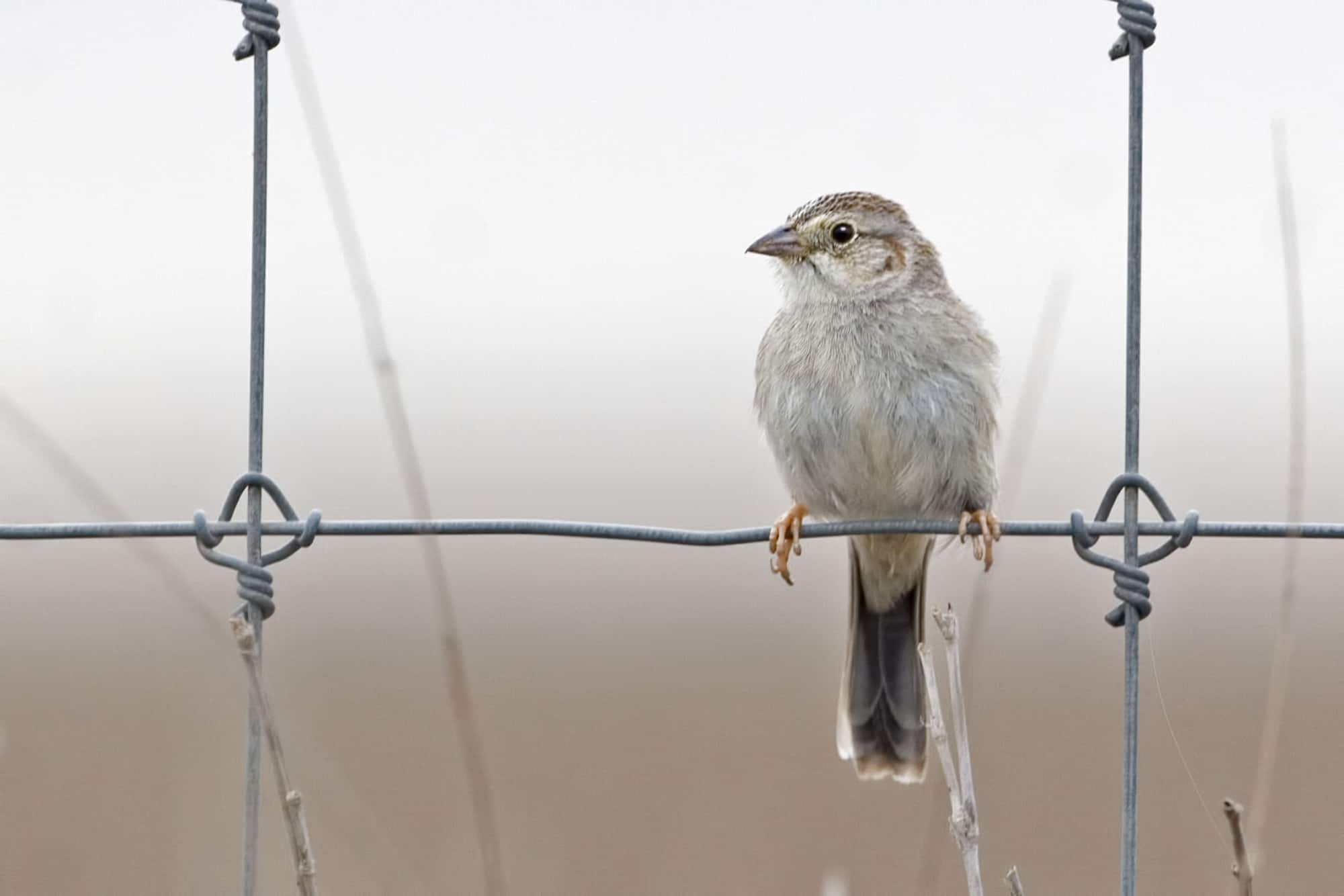
- Peucaea cassinii
- ORDER: Passeriformes
- FAMILY: Passerellidae
- Length: 5.1-5.9 in (13-15 cm)
- Weight: 0.6-0.7 oz (16-21 g)
- Wingspan: 7.9 in (20 cm)
Cassin’s Sparrows don’t have a lot to make them stand out, but their plainness can actually help you identify them. They just don’t have a lot of contrast in their coloring. Their bodies are grayish-brown, and the streaking on their backs and wing is slightly darker.
Looking at their silhouette can help. Cassin’s Sparrows have long tails and long bills. They are bigger than other sparrows you might see them with.
They breed in Kasas’s High Plains, usually in shrubby grasslands that have cacti, yucca plants, or small trees scattered about. Unlike sparrows that hide in thickets and protective underbrush, Cassin’s Sparrows will spend more time out in the open.
Chipping Sparrow
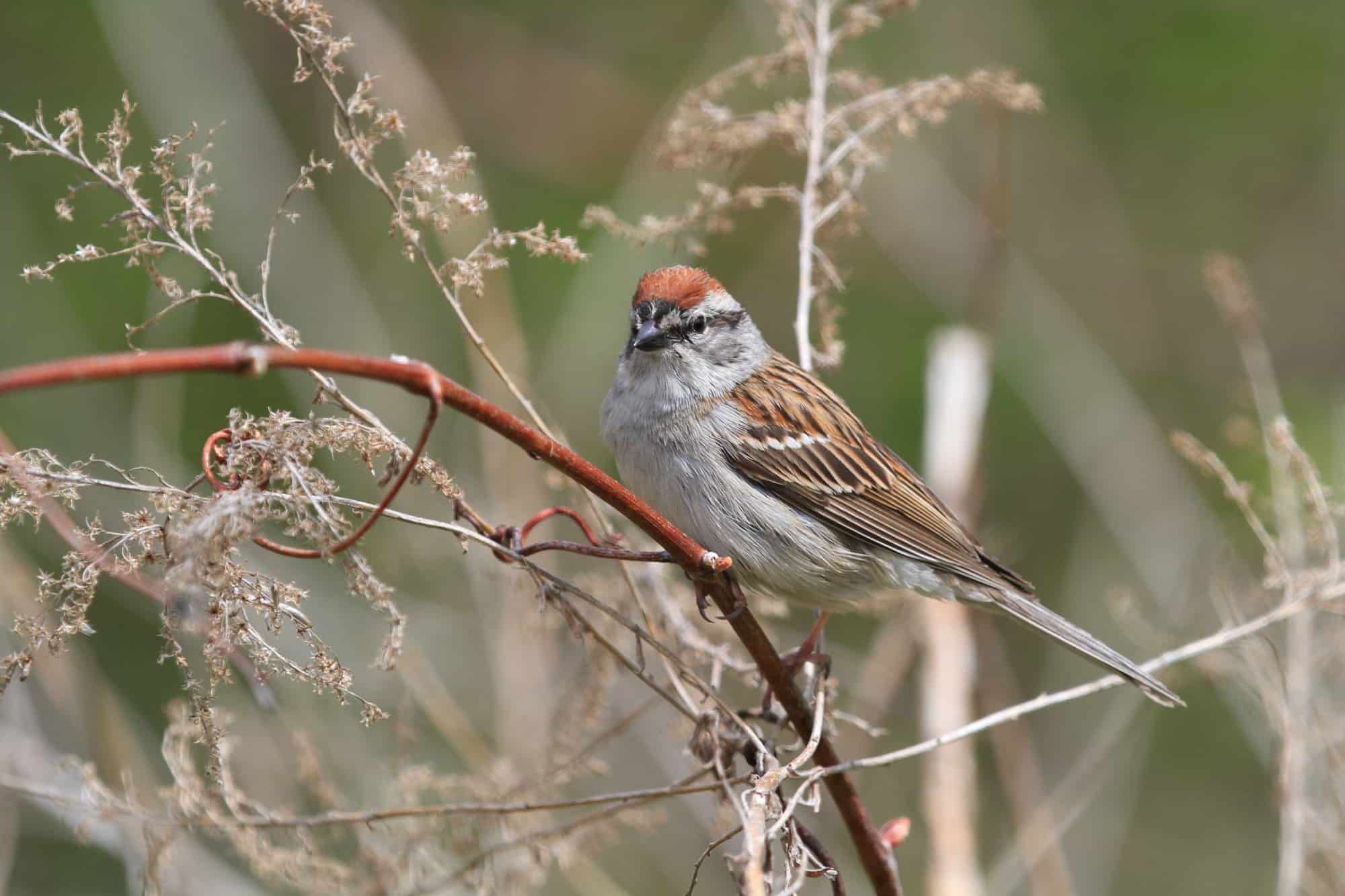
- Spizella passerina
- ORDER: Passeriformes
- FAMILY: Passerellidae
- Length: 4.7-5.9 in (12-15 cm)
- Weight: 0.4-0.6 oz (11-16 g
- Wingspan: 8.3 in (21 cm)
The Chipping Sparrow is a widespread North American sparrow that breeds in almost every US state and most of Canada. They spend the winter in Florida, Mexico, and the Caribbean. Some Chipping Sparrows are year-round residents of Central America.
Male Chipping Sparrows have dark streaks on their wings and back. Their rufous cap makes them stand out, as do the black eye stripes. Females are similarly patterned but are darker.
Chipping Sparrows eat a lot of insects and bugs, helping with pest control. They eat leafhoppers, caterpillars, beetles, crickets, grasshoppers, and spiders.
Their open cup-shaped nest is made from weeds, roots, and stems. They breed in open prairies like the East Kansas Prairie, but they only migrate through the western three-quarters of the state.
Eastern Towhee

- Pipilo erythrophthalmus
- ORDER: Passeriformes
- FAMILY: Passerellidae
- Length: 6.8-8.2 in (17.3-20.8 cm)
- Weight: 1.1-1.8 oz (32-52 g)
- Wingspan: 7.9-11.0 in (20-28 cm)
Eastern Towhees stand out from other sparrows. The male has a jet-black head, neck, and back. He is white-bellied with rufous sides. Females are similarly patterned, but they are brown instead of black.
Listen for the distinctive “chewink” call, often coming from the protective undergrowth where they hide. They are found most frequently in shrubby forests.
Eastern Towhees breed throughout most of the eastern US. Their breeding territory just barely extends into eastern Kansas, although some will also spend the winter in the Flint Hills Uplands.
Grasshopper Sparrow
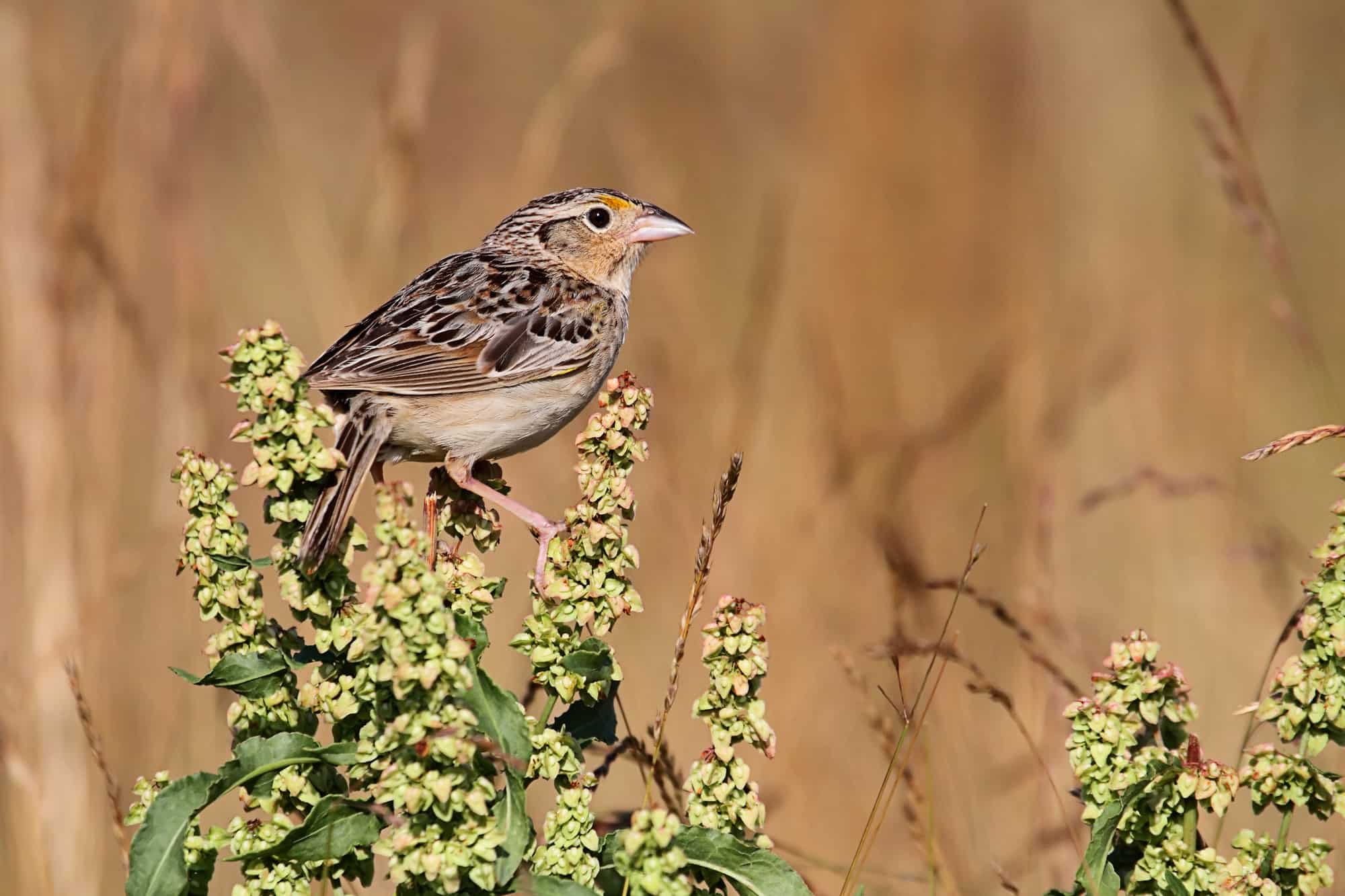
- Ammodramus savannarum
- ORDER: Passeriformes
- FAMILY: Passerellidae
- Length: 4.3-4.5 in (10.8-11.5 cm)
- Weight: 0.5-0.7 oz (14-20 g)
- Wingspan: 7.9 in (20 cm)
Grasshopper Sparrows eat grasshoppers, but that’s not where they get their name. Their name comes from the fact that they make a grasshopper-sounding “buzzz” sound. Male Grasshopper Sparrows are also unusual because they have two songs. In addition to the vibrating buzzing sound, they also sing a squeaky, melodic song.
Grasshopper Sparrows have a relatively muted appearance with colors that range from tan and light orange to gray. Their necks are quite thick, and they have flat heads, large bills, and stubby tails.
They are found throughout Kansas during the breeding season. You will likely see them on barbed wire fences that line shrubby fields.
Henslow’s Sparrow
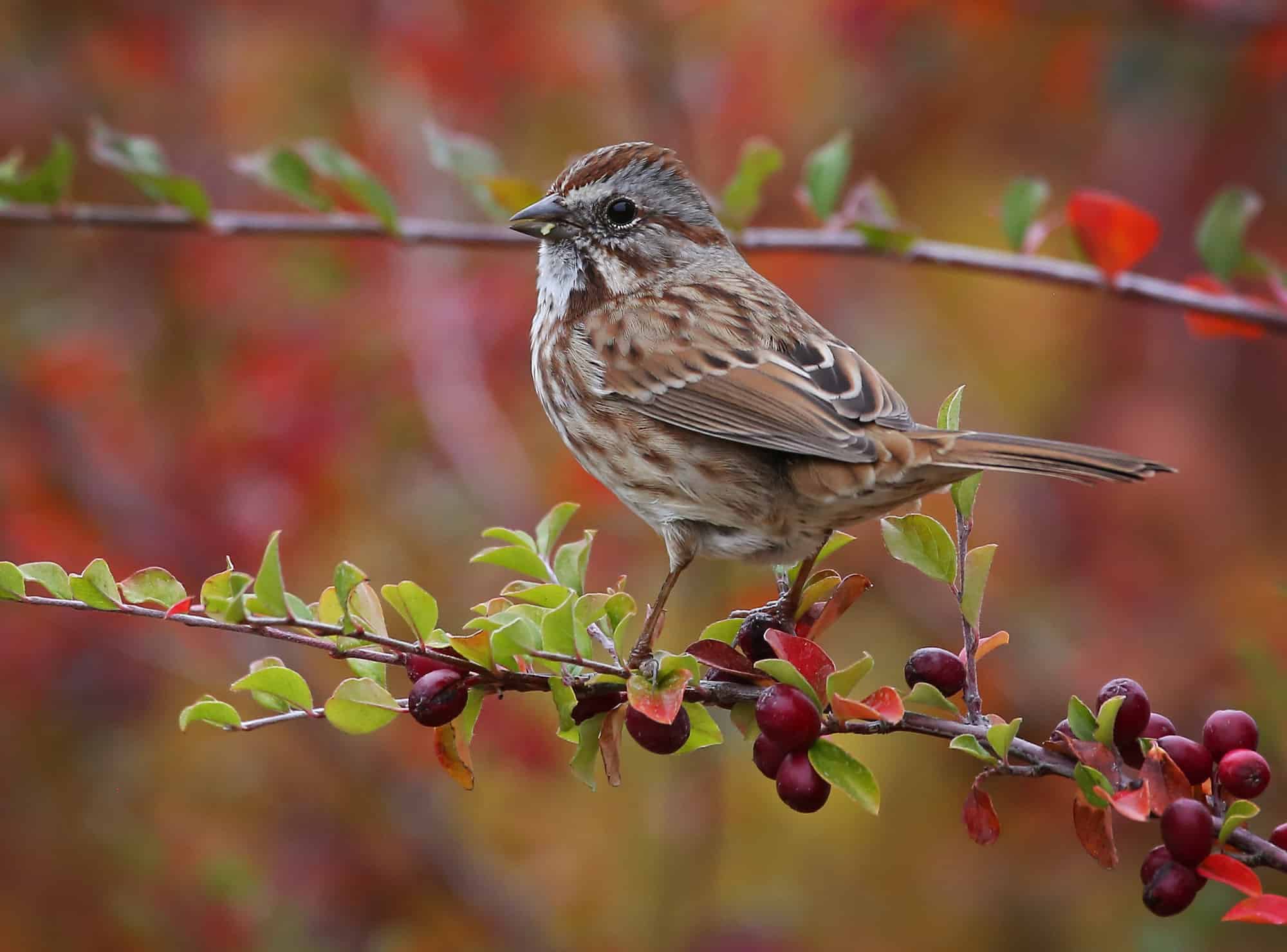
- Centronyx henslowii
- ORDER: Passeriformes
- FAMILY: Passerellidae
- Length: 4.7-5.9 in (12-15 cm)
- Weight: 0.4-0.6 oz (11-16 g)
- Wingspan: 8.3 in (21 cm)
The plain-looking Henslow’s Sparrow is mostly buff with a pale green wash of color. They have stark black stripes on their backs and wings.
They nest on the ground and protect their nests from predators by hiding them in tall grasses. Their summer diet includes a lot of bugs and insects, including stink bugs, crickets, beetles, grasshoppers, and caterpillars. They will even eat wasps!
In the winter, they switch to a seed-based diet.
In Kansas, Henslow’s Sparrows are only found in the Osage Cuestas region, and only during the summer.
Lark Bunting
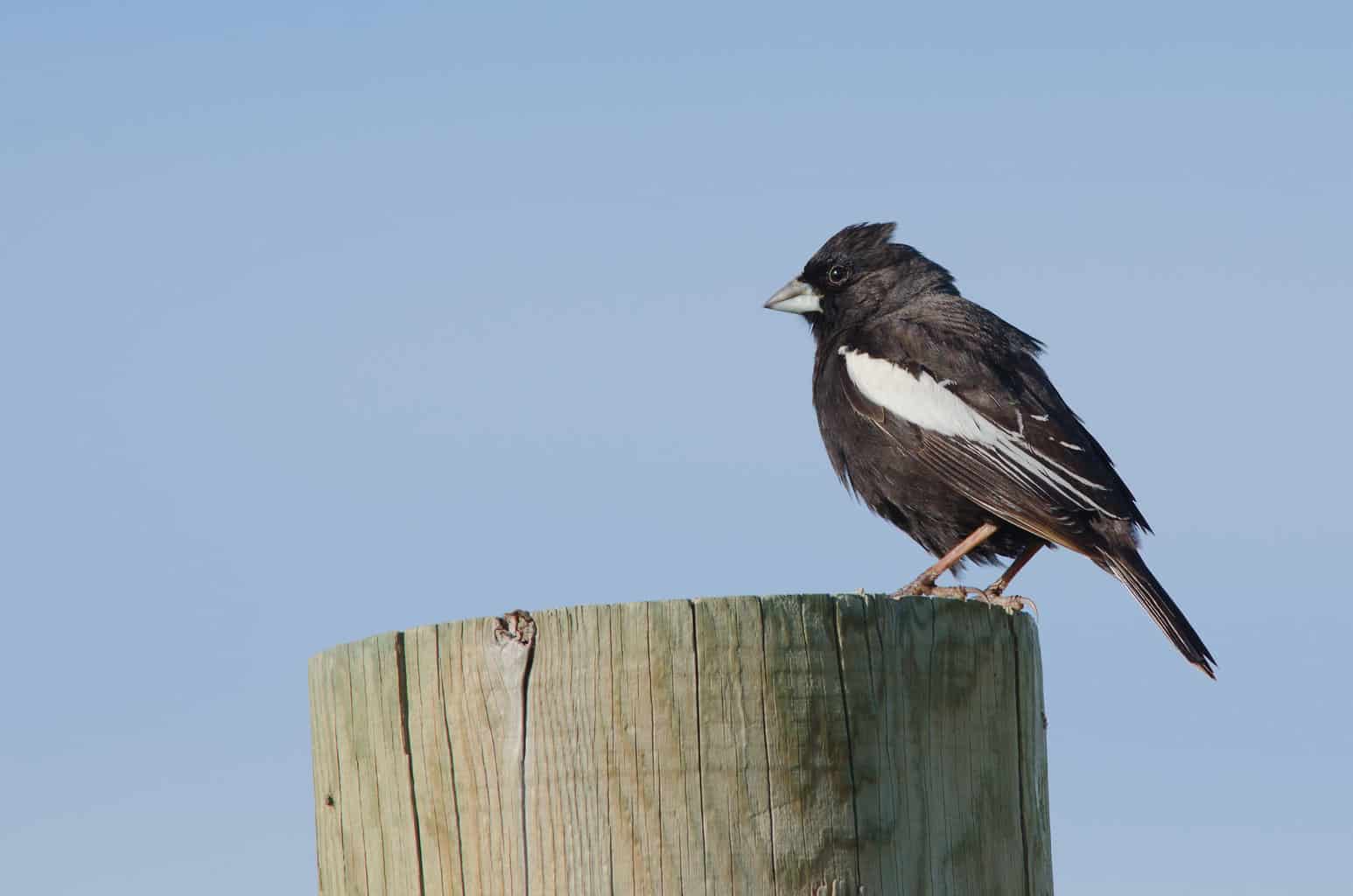
- Calamospiza melanocorys
- ORDER: Passeriformes
- FAMILY: Passerellidae
- Length: 5.5-7.1 in (14-18 cm)
- Weight: 1.3-1.5 oz (35.3-41.3 g)
- Wingspan: 9.8-11.0 in (25-28 cm)
The Lark Bunting male is easy to recognize in the summer, as he is dark black with white patches all over his back and wings. However, during the rest of the year, both males and females are streaky and brown. All Lark Buntings, regardless of sex or season, have a blue-gray bill.
They need shrubby grassland instead of pure grassland, as they usually nest at the base of a shrub or cactus. They don’t breed in Glaciated Region or Osage Cuestas in the east, but they do breed in most of the rest of the state.
Lark Sparrow
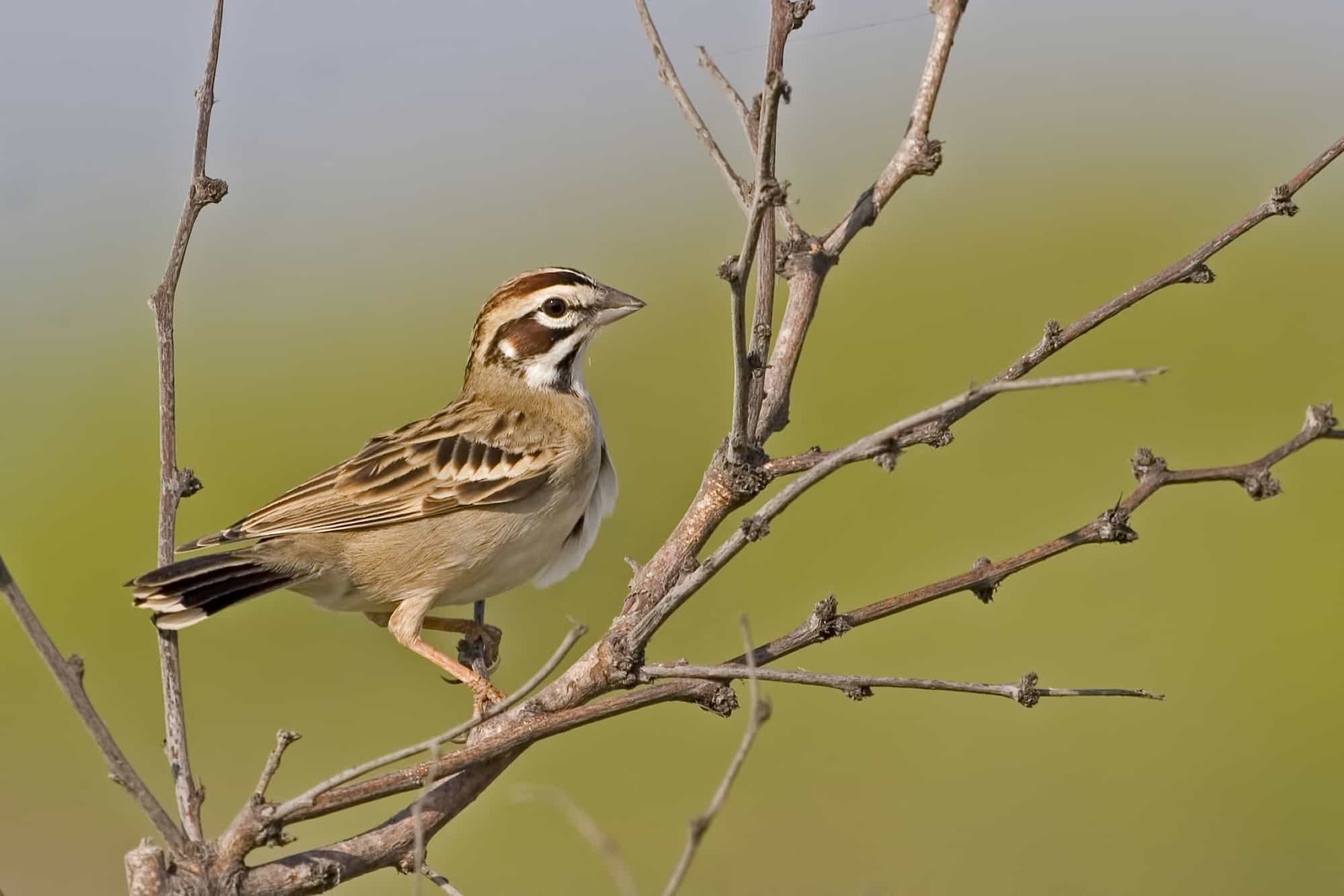
- Chondestes grammacus
- ORDER: Passeriformes
- FAMILY: Passerellidae
- Length: 5.9-6.7 in (15-17 cm)
- Weight: 0.8-1.2 oz (24-33 g)
- Wingspan: 11.0 in (28 cm)
The Lark Sparrow is bulky with a long, rounded tail. Its face is lined with dark brown stripes, and the rest of its body is mostly light gray. It has some brown on the wings, too. The most distinctive marking on the Lark Sparrow is a black spot in the middle of the chest.
Lark Sparrows are ground foragers, but you may also see them in the trees or bushes when they have been startled.
They nest across Kansas. Their preferred nesting habitat is dry grassland with plenty of shrubs. Overgrazed pastures are perfect.
Sparrows in Kansas in the Winter
Some sparrows arrive in Kansas in the fall to spend the winter here. These birds have often raised their young in Canada or the western US states, and Kansas makes a perfect winter habitat. These sparrows are the American Tree Sparrow, the Dark-Eyed Junco, the Fox Sparrow, the Harris’s Sparrow, the Song Sparrow, the Spotted Towhee, The Swamp Sparrow, and the White-Throated Sparrow.
American Tree Sparrow
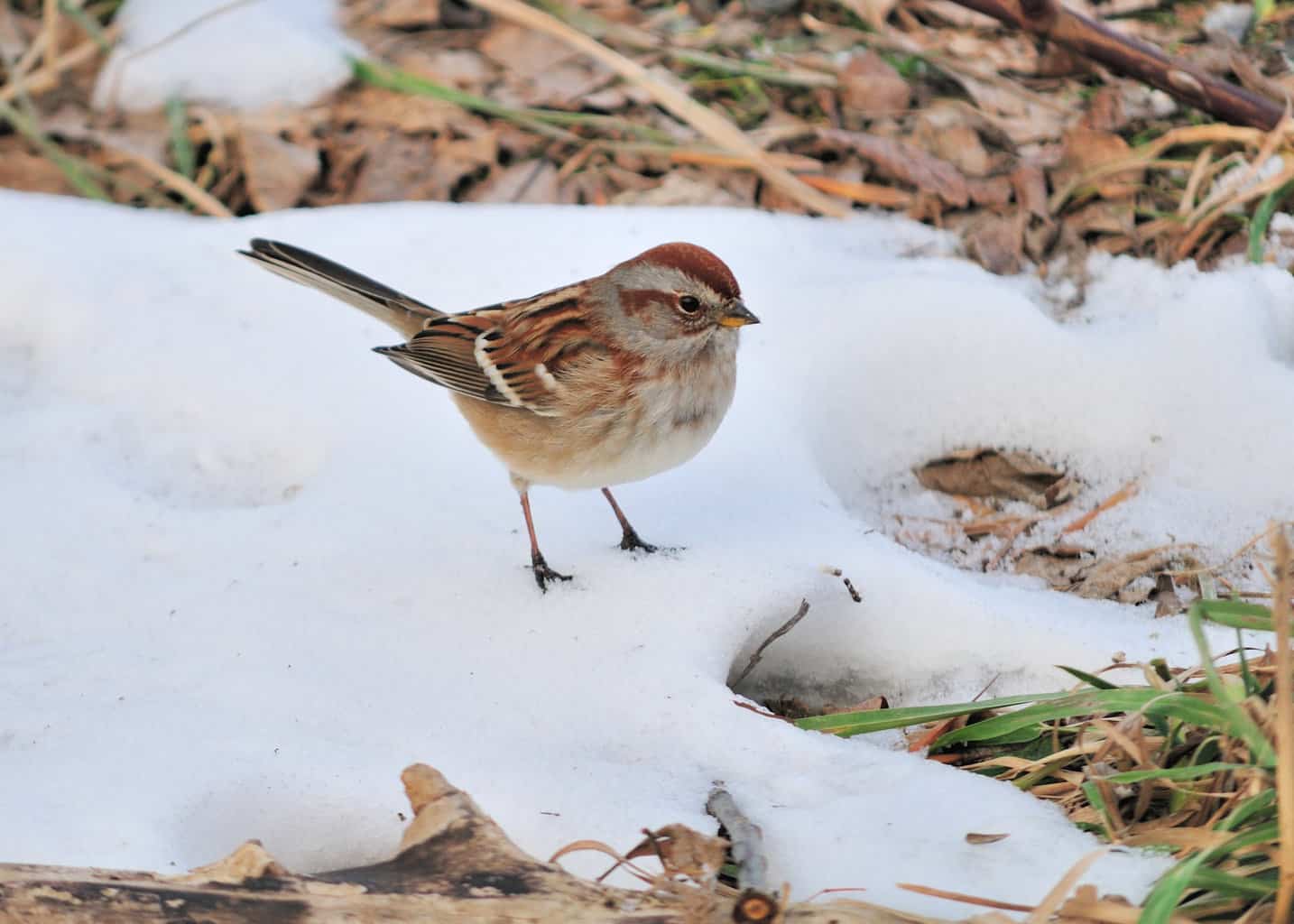
- Spizelloides arborea
- ORDER: Passeriformes
- FAMILY: Passerellidae
- Length: 5.5 in (14 cm)
- Weight: 0.5-1.0 oz (13-28 g)
- Wingspan: 9.4 in (24 cm)
Some American Tree Sparrows have an easy-to-spot red patch on the breast, but unfortunately, not all of them. This inconsistency makes them a bit of an identification challenge.
They have gray bodies and dark red crowns with striped wings.
Their breeding territory stretches across northern Canada. They move into the US – including the Great Plains region – in the late fall. They are often found in snowy fields in Kansas or perched on goldenrod. They eat constantly, as American Tree Sparrows need to consume 30% of their body weight in insects, seeds, and nuts every day.
Dark-Eyed Junco
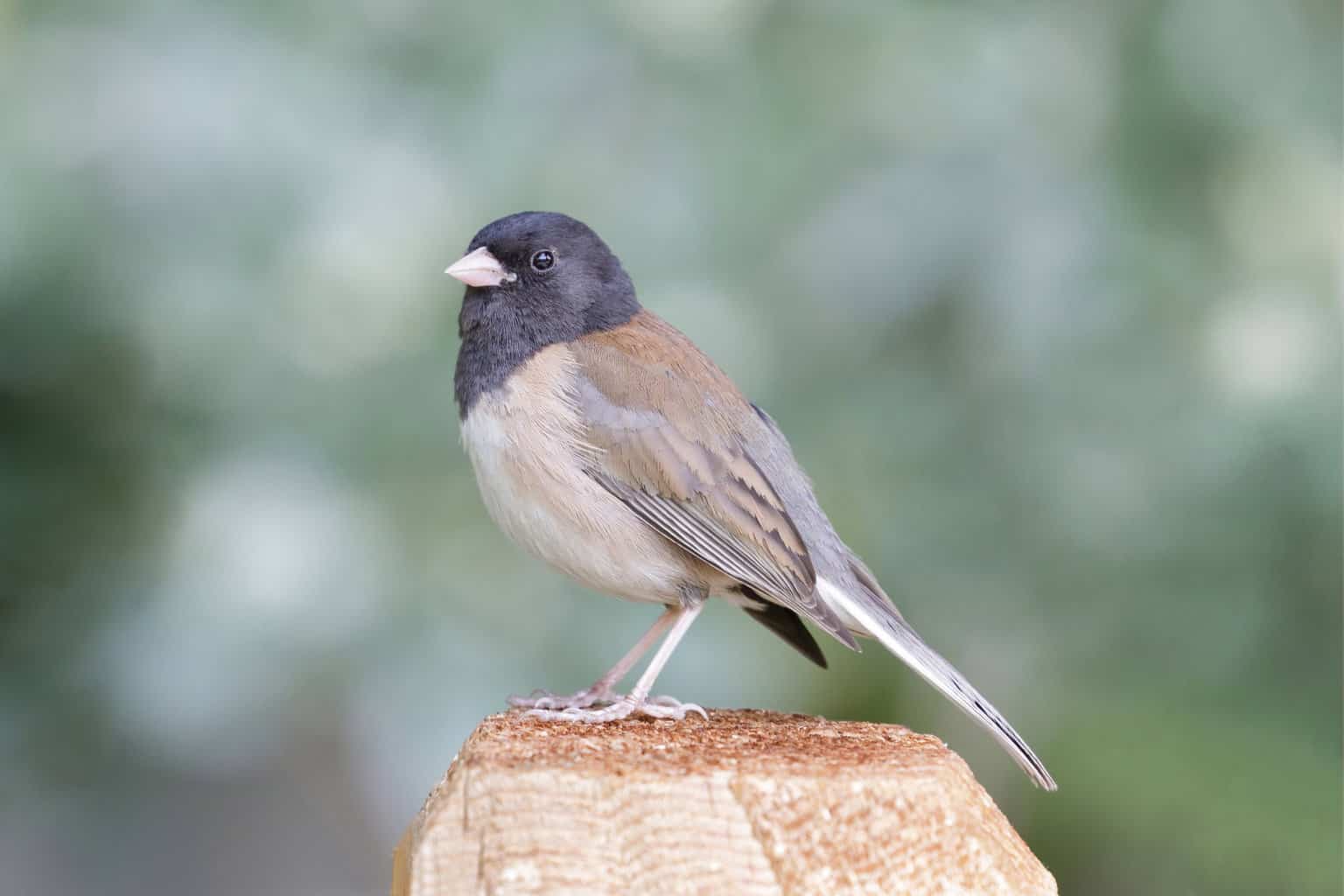
- Junco hyemalis
- ORDER: Passeriformes
- FAMILY: Passerellidae
- Length: 5.5-6.3 in (14-16 cm)
- Weight: 0.6-1.1 oz (18-30 g)
- Wingspan: 7.1-9.8 in (18-25 cm)
Dark-Eyed Juncos are found throughout Kansas in the winter. They are frequently associated with the arrival of cold weather, and sometimes they aren’t even noticed until it starts to snow. Because of this, they are often called “Snowbirds.”
They have round, dark-colored bodies. They are dark gray on top with a pale-gray belly and chest. They also have some white coloring on their outer tail feathers, plus a pink bill.
They can be found in the woods, in parks, in fields, and in backyards. They are common visitors to backyard bird feeders. If you put out birdseed in the winter in Kansas, you will likely attract Dark-Eyed Juncos to your yard.
Fox Sparrow

- Passerella iliaca
- ORDER: Passeriformes
- FAMILY: Passerellidae
- Length: 5.9-7.5 in (15-19 cm)
- Weight: 0.9-1.6 oz (26-44 g)
- Wingspan: 10.5-11.4 in (26.7-29 cm)
The reddish-brown and gray Fox Sparrow can vary a lot from bird to bird. Depending on the region you’re in and the individual bird you encounter, Fox Sparrows can be almost entirely red or mostly gray with just a few red stripes. Look for thick brown spots on their chests to identify them.
Fox Sparrows are notoriously messy little birds, kicking around in the leaf litter as they look for summertime insects and winter seeds. They will do this right underneath your birdfeeder, too, so watch for a flutter of activity at the base of your feeder.
Individual Fox Sparrows have been found in countries like Germany, Italy, Iceland, and Greenland. They likely arrived there by ship.
Fox Sparrows spend the winter in southeastern Kansas but aren’t really present anywhere in the state.
Harris’s Sparrow
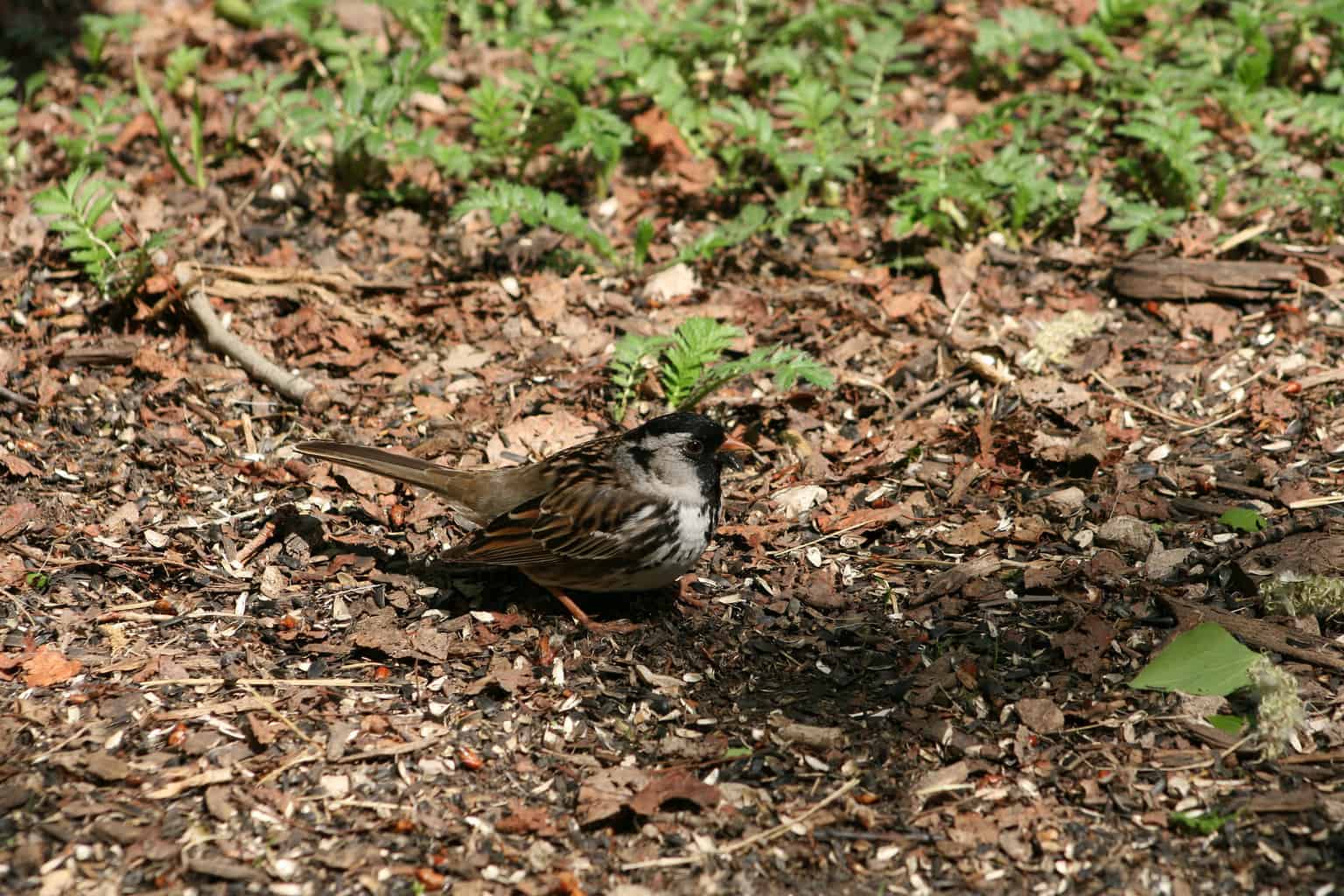
- Zonotrichia querula
- ORDER: Passeriformes
- FAMILY: Passerellidae
- Length: 6.7-7.9 in (17-20 cm)
- Weight: 0.9-1.7 oz (26-49 g)
- Wingspan: 10.6 in (27 cm)
The male Harris’s Sparrow has distinctive black coloring on his face, bib, and crown. On juvenile males, this area is much patchier in appearance. As they mature, it becomes darker.
Harris’s Sparrows have gray cheeks and a gray nape during the breeding season. During the winter, when you will see these birds in Kansas, their cheeks and nape are brown.
They have white bellies, pink bills, and black wing and back stripes.
Following Towhees, Harris’s Sparrows are the largest sparrows in North America. Something that makes Harris’s Sparrow unique is that it is the only songbird that breeds exclusively in Canada.
Following the breeding season, Harris’s Sparrows arrive in Kansas for the winter. Harris’s Sparrows are widespread here during the winter, but overall, their winter territory is actually quite small. It covers Kansas and parts of Nebraska, Oklahoma, and Texas.
Song Sparrow

- Melospiza melodia
- ORDER: Passeriformes
- FAMILY: Passerellidae
- Length: 4.7-6.7 in (12-17 cm)
- Weight: 0.4-1.9 oz (12-53 g)
- Wingspan: 7.1-9.4 in (18-24 cm)
There is a lot of regional variation in Song Sparrows, but all of them are brown with white streaks on their chests. They also have thick, white flanks. The biggest difference from one variety to the next is how much streaking they have and where they fall in the spectrum from light brown to reddish brown.
Song Sparrows are creatures of habit and will return to the exact same place where they nested the year before. If possible, they will even move into the exact same nest.
They winter throughout Kansas, with some staying year-round in a very small area in the northeast corner of the state.
Spotted Towhee
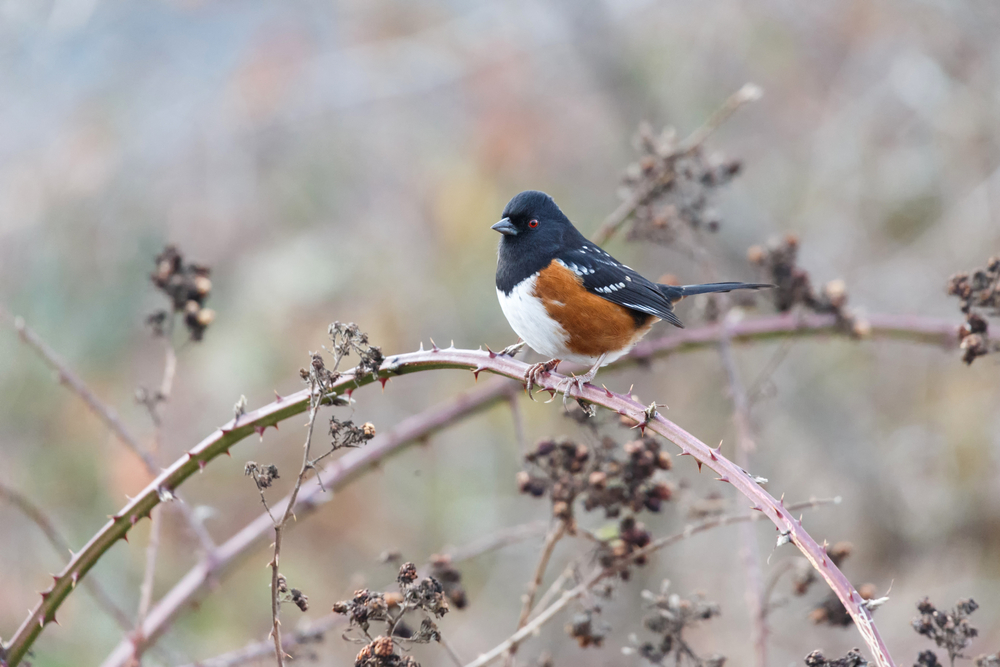
- Pipilo maculatus
- ORDER: Passeriformes
- FAMILY: Passerellidae
- Length: 6.7-8.3 in (17-21 cm)
- Weight: 1.2-1.7 oz (33-49 g)
- Wingspan: 11.0 in (28 cm)
Spotted Towhees are large in comparison to other sparrows, but small birds overall. The male has a dark black throat, head, and wings, plus a white belly and rufous sides. Though they have a similar pattern as the Eastern Towhee, one thing sets them apart: white spots all over their black wings.
The female is similarly patterned. Where the male is black, she is grayish-brown.
Spotted Towhees live in the southeastern half of Kansas during the winter. Although they eat plenty of bugs and insects in the summer (like weevils, grasshoppers, beetles, ladybugs, caterpillars, moths, wasps, and bees), their winter habitat is mostly seed-based.
In Kansas, their winter diet can consist of raspberries, thistles, blackberries, sumac, poison oak, oats, corn, cherries, chickweed, and more.
Swamp Sparrow
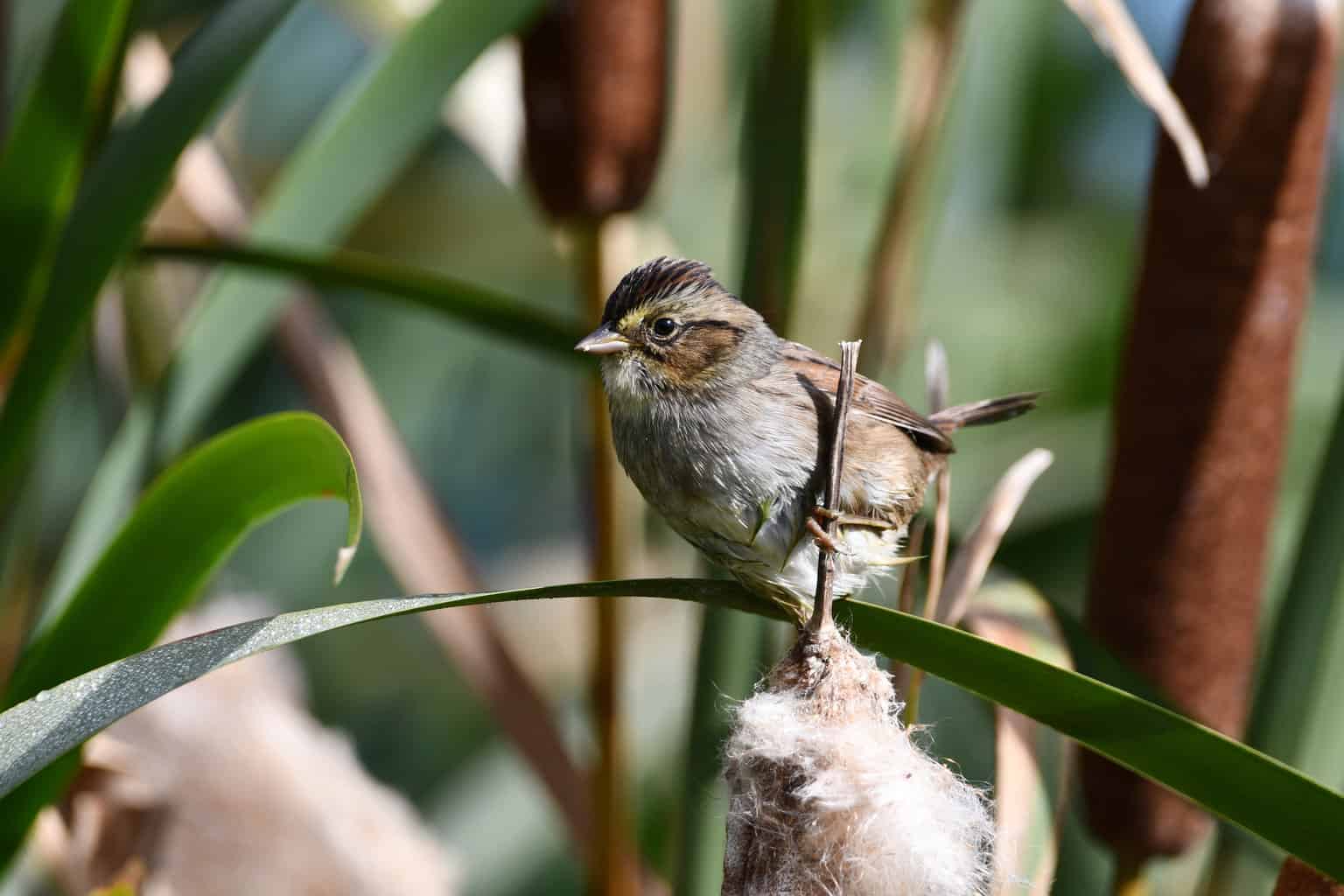
- Melospiza georgiana
- ORDER: Passeriformes
- FAMILY: Passerellidae
- Length: 4.7-5.9 in (12-15 cm)
- Weight: 0.5-0.8 oz (15-23 g)
- Wingspan: 7.1-7.5 in (18-19 cm)
The Swamp Sparrow is sometimes mixed up with two other sparrows: the Song Sparrow and the Chipping Sparrow. There are easy ways to differentiate them from one another, though.
First, Swamp Sparrows are confused with Song Sparrows because they have very similar shapes and sizes. They are both round-bodied with long tails. However, Swamp Sparrows have a rufous-brown cap on their heads that Song Sparrows don’t.
That rufous cap could lead people to confuse the Swamp Sparrow with the Chipping Sparrow. But take note – Swamp Sparrows are much larger and bulkier than the more delicate-looking Chipping Sparrow. Another difference is that Swamp Sparrows are much more isolated from humans and from each other. They only flock together during their migration.
Swamp Sparrows prefer wetlands, like marshes and swamps. Those long, thick legs are perfect for foraging in the mud for food.
Swamp Sparrows have a rufous head, rufous wings, grayish-white undersides, and long legs.
They migrate through the western half of Kansas and breed in the eastern part of the state.
White-Throated Sparrow
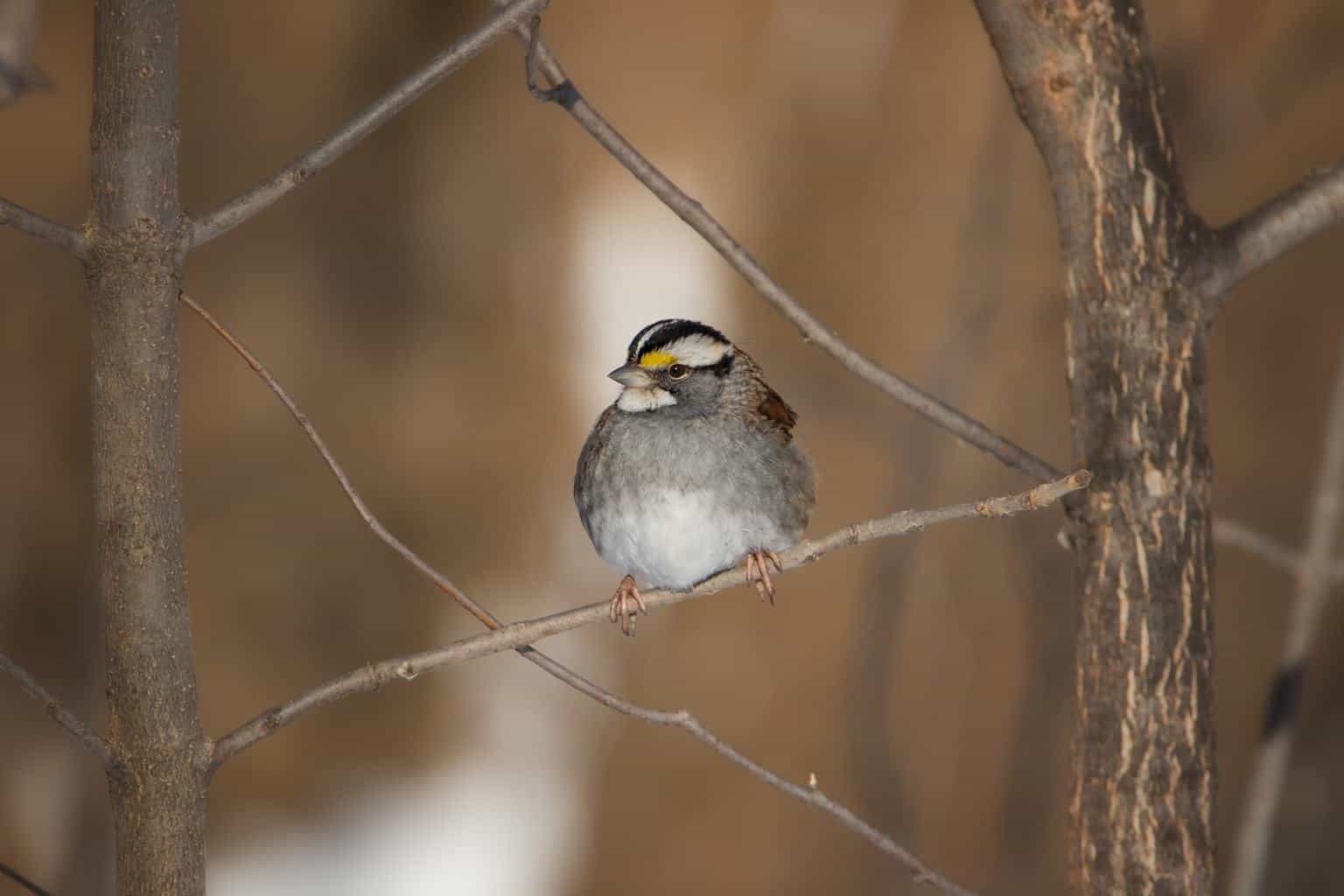
- Zonotrichia albicollis
- ORDER: Passeriformes
- FAMILY: Passerellidae
- Length: 6.3-7.1 in (16-18 cm)
- Weight: 0.8-1.1 oz (22-32 g)
- Wingspan: 7.9-9.1 in (20-23 cm)
With such an obvious name, it’s easy to identify White-Throated Sparrows. They are dark brown in color with a contrasting white throat. They also have black stripes on their heads and across their eyes.
Their lores (the space between a bird’s eyes and bill) are yellow.
White-Throated Sparrows are found in a few parts of Kansas: the northeast region, the southeast region, and all along the Arkansas River Lowlands.
Look for White-Throated Sparrows in open woodland with plenty of shrubs for shelter.
Sparrows in Kansas During Migration
Twice a year, several kinds of sparrows make their way through Kansas on their migratory journeys. Migration habits vary from species to species, but typically, migration runs from March-May and again from September-October. The sparrows you’ll find in Kansas during migration are: the Brewer’s Sparrow, the Clay-Colored Sparrow, the Green-Tailed Towhee, the LeConte’s Sparrow, the Lincoln’s Sparrow, the Savannah Sparrow, and the Vesper Sparrow.
Brewer’s Sparrow
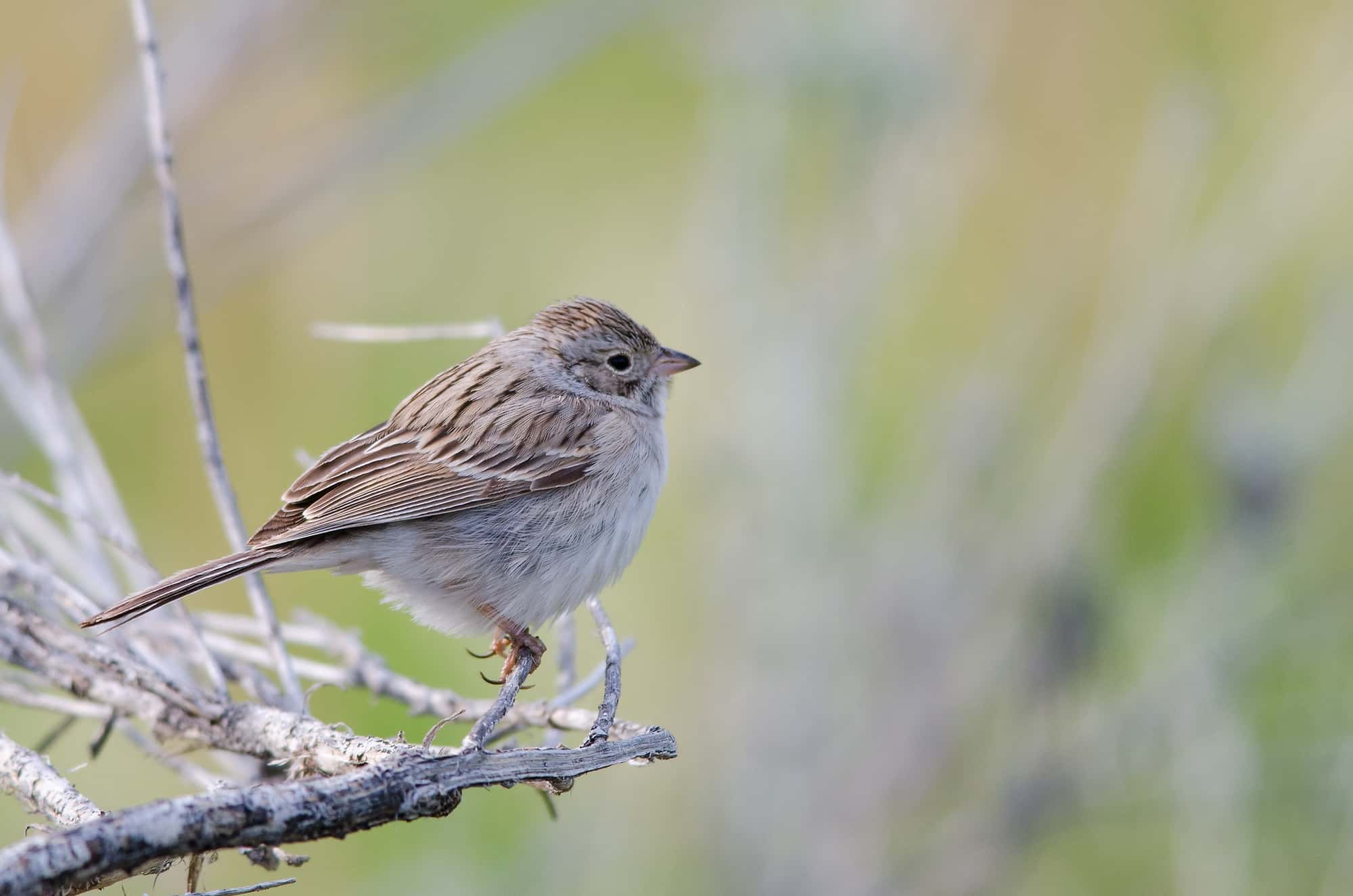
- Spizella breweri
- ORDER: Passeriform
- FAMILY: Passerellidae
- Length: 5.1-5.9 in (13-15 cm)
- Weight: 0.4-0.5 oz (11-14 g)
- Wingspan: 7.1-7.9 in (18-20 cm)
The Brewer’s Sparrow is the smallest kind of sparrow in North America. They are gray-brown and have brown stripes on their back and neck. They also have a notched tail, rounded wings, a white eyering, and a light gray stripe above their eyes.
Brewer’s Sparrows are exclusive to the western half of North America, especially the US. They are early fall migrants and mid-to-late spring migrants.
They are the most abundant bird in the interior west of the US. Listen for the long, trilling sound of the male. Other than when they are singing, Brewer’s Sparrows tend to stay hidden in the underbrush.
Kansas sees migratory Brewer’s Sparrows throughout much of the state, but some Brewer’s Sparrows do breed along the very western edge of Kansas in the High Plains.
Clay-Colored Sparrow
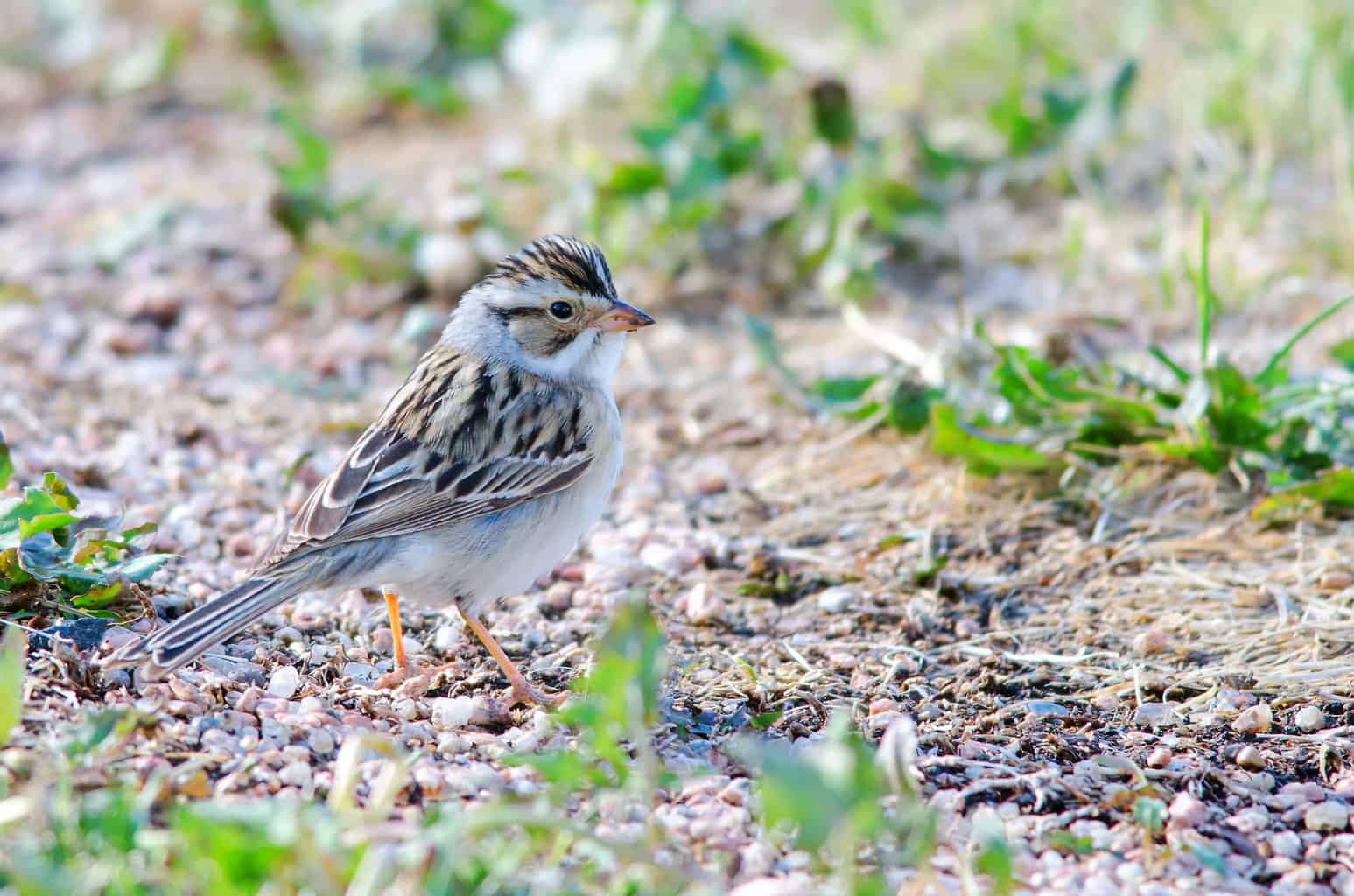
- Spizella pallida
- ORDER: Passeriformes
- FAMILY: Passerellidae
- Length: 5.1–6 in (130–150 mm)
- Weight: 12 g (0.42 oz)
- Wingspan: 7.5 in (190 mm)
Clay-Colored Sparrows are, as their name implies, the color of gray clay. They also have a pale gray collar around the neck and some fine, dark streaks on their heads.
Though they are declining in numbers, they are the most common songbird in the US’s northern prairies. In Kansas, they are exclusively migratory visitors. Clay-Colored Sparrows are called “complete migrants,” which means there is no overlap between where they live in the summer and where they live in the winter.
Green-Tailed Towhee
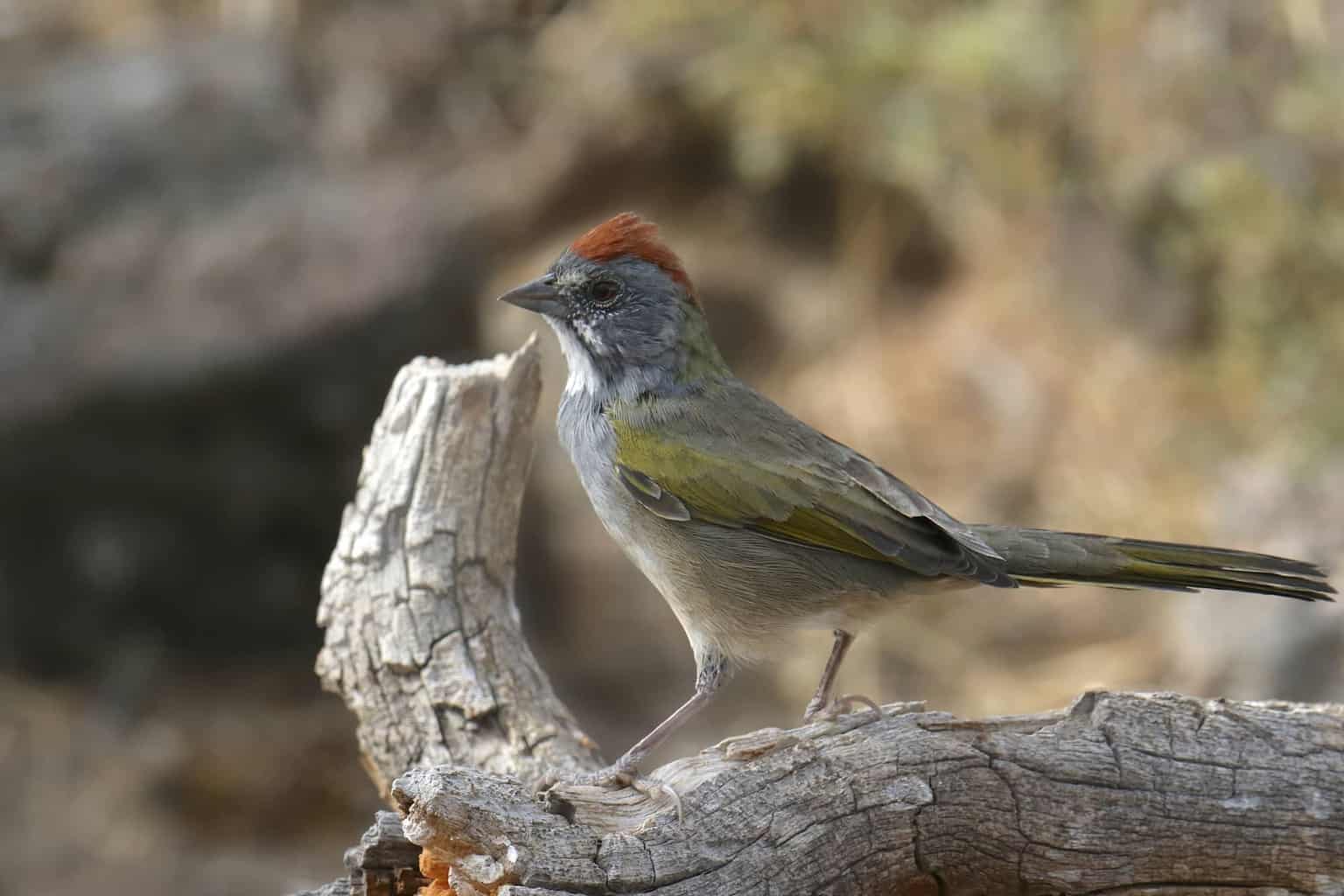
- Pipilo chlorurus
- ORDER: Passeriformes
- FAMILY: Passerellidae
- Length: 8.3-9.8 inches (21–25 cm)
- Weight: 1.3-2.4 oz (37-67 g)
- Wingspan: 11.4 inches (29 cm)
The Green-Tailed Towhee is a lovely little bird. In fact, it is probably one of the prettiest sparrows in Kansas.
They have gray bodies with beautiful green on their wings and tails. The Green-Tailed Towhee’s crown is bright, rufous brown. Adding some more contrast to their overall appearance, they have a white throat and a dark mustache stripe on their face.
Unfortunately, most Kansans will not get to see this bird in the wild. Their migratory path takes them along the western border, but they barely make their way into the state. Look for them in the spring and fall west of Ulysses, Hugoton, and Liberal.
LeConte’s Sparrow
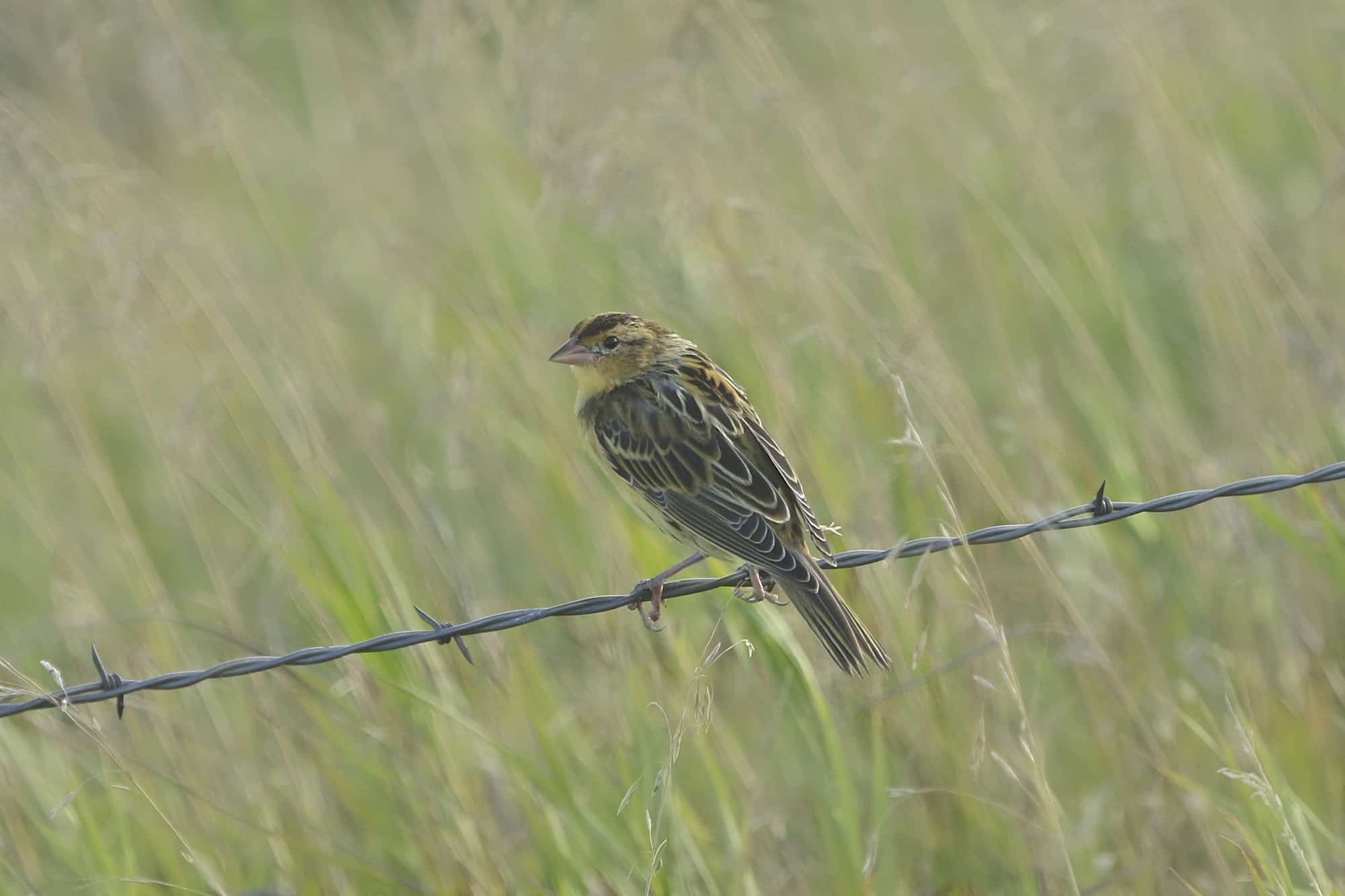
- Ammospiza leconteii
- ORDER: Passeriformes
- FAMILY: Passerellidae
- Length: 4.7-5.1 in (12-13 cm)
- Weight: 0.4-0.6 oz (12-16.3 g)
- Wingspan: 6.3-7.1 in (16-18 cm)
LeConte’s Sparrows are not easy to find. They are excellent camouflagers, and they almost never come out of the thickets and underbrush where they live. They are also experiencing population decline and are found on the Yellow Watch List.
They do have high-pitched, sharp calls that can alert you to their whereabouts, but it will take some time – and patience! – to see them.
LeConte’s Sparrows are orangeish-brown. They are darkest on their head and breast, and they have streaked black wings and backs. A grayish-purple patch on the back of the neck is sometimes visible. They are thick sparrows and have flat heads with very short wings.
LeConte’s Sparrows breed in the remote Canadian wilderness and spend the summer in the west, south, and central US. They migrate through Kansas, and some may stay for the winter in the southeast corner of the state, close to Joplin, Missouri.
Lincoln’s Sparrow
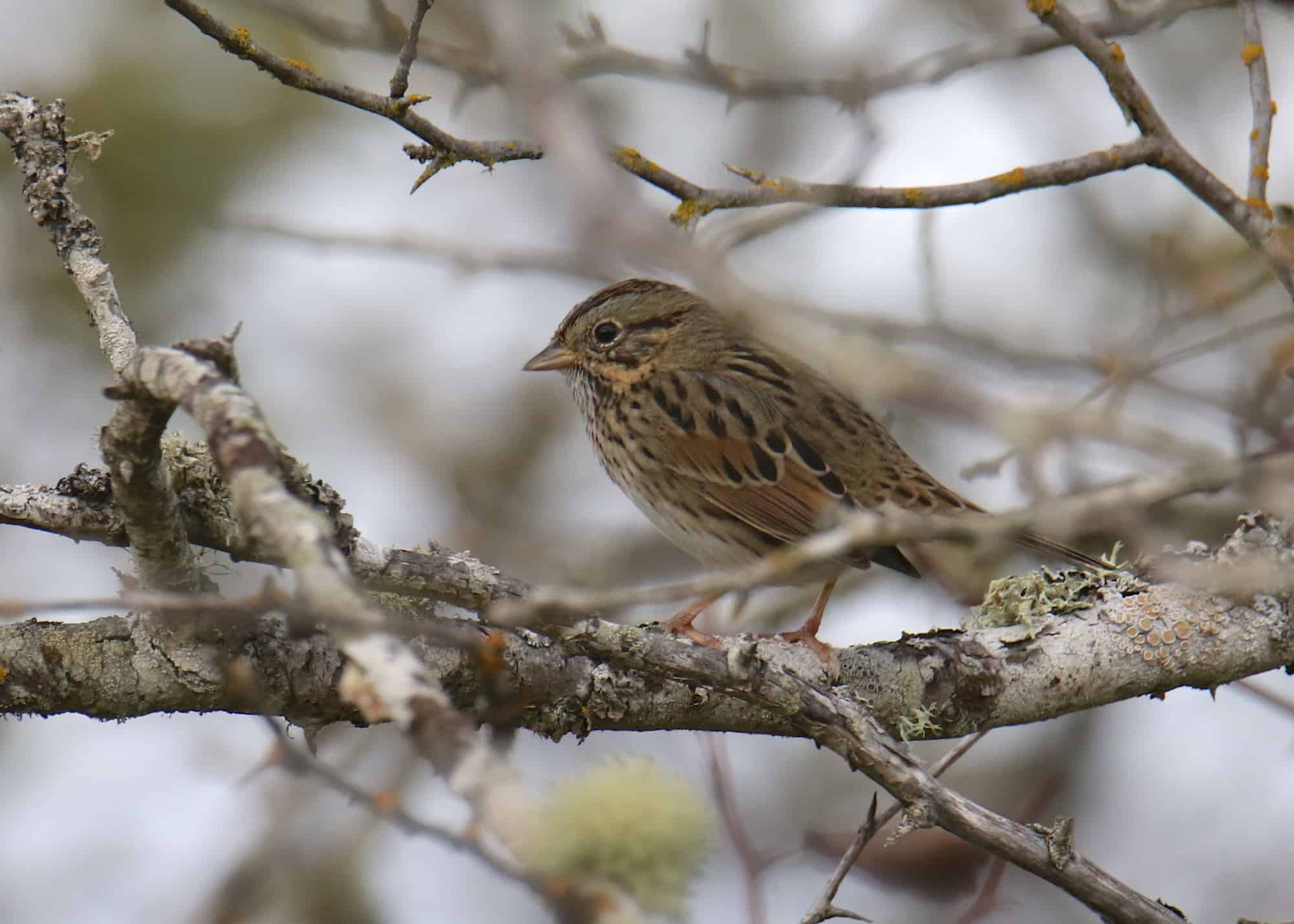
- Melospiza lincolnii
- ORDER: Passeriformes
- FAMILY: Passerellidae
- Length: 5.1-5.9 in (13-15 cm)
- Weight: 0.6-0.7 oz (17-19 g)
- Wingspan: 7.5-8.7 in (19-22 cm)
The Lincoln’s Sparrow is striped in dark brown and gray. Their tails and wings are tipped in brown. They have white bellies, a pale mustache, and a light gray stripe down the middle of their brown crown.
Female Lincoln’s Sparrows build ground-level nests. They tend to choose willows and birch shrubs as their ideal nesting ground.
South of 335 from Wichita to Kansas City, Lincoln’s Sparrows are winter residents. However, in the rest of the state, they are only visitors during their migration journeys. Listen for them in thickets along forest edges in the spring and fall.
Savannah Sparrow
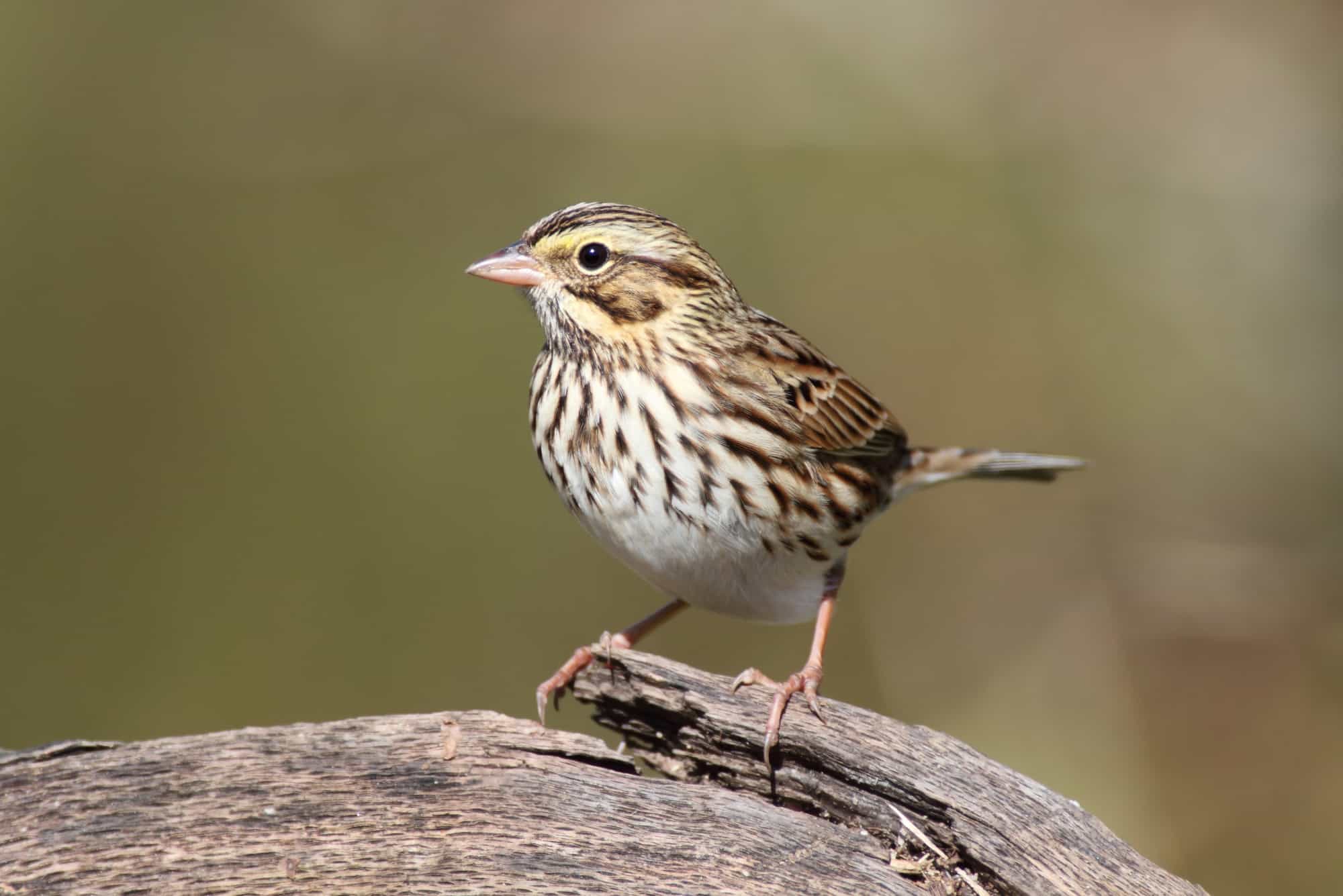
- Passerculus sandwichensis
- ORDER: Passeriformes
- FAMILY: Passerellidae
- Length: 4.3-5.9 in (11-15 cm)
- Weight: 0.5-1.0 oz (15-28 g)
- Wingspan: 7.9-8.7 in (20-22 cm)
Savannah Sparrows have small heads and dark streaks on their backs and wings. They have a sharp little bill and some yellow coloring between their eyes and bill. That yellow is key to identifying them easily.
Savannah Sparrows breed across most of the US, and yet they are only migratory visitors to Kansas. They are early spring and late fall migrants who have been documented throughout Kansas as they make their journey. They migrate in very large flocks.
Vesper Sparrow
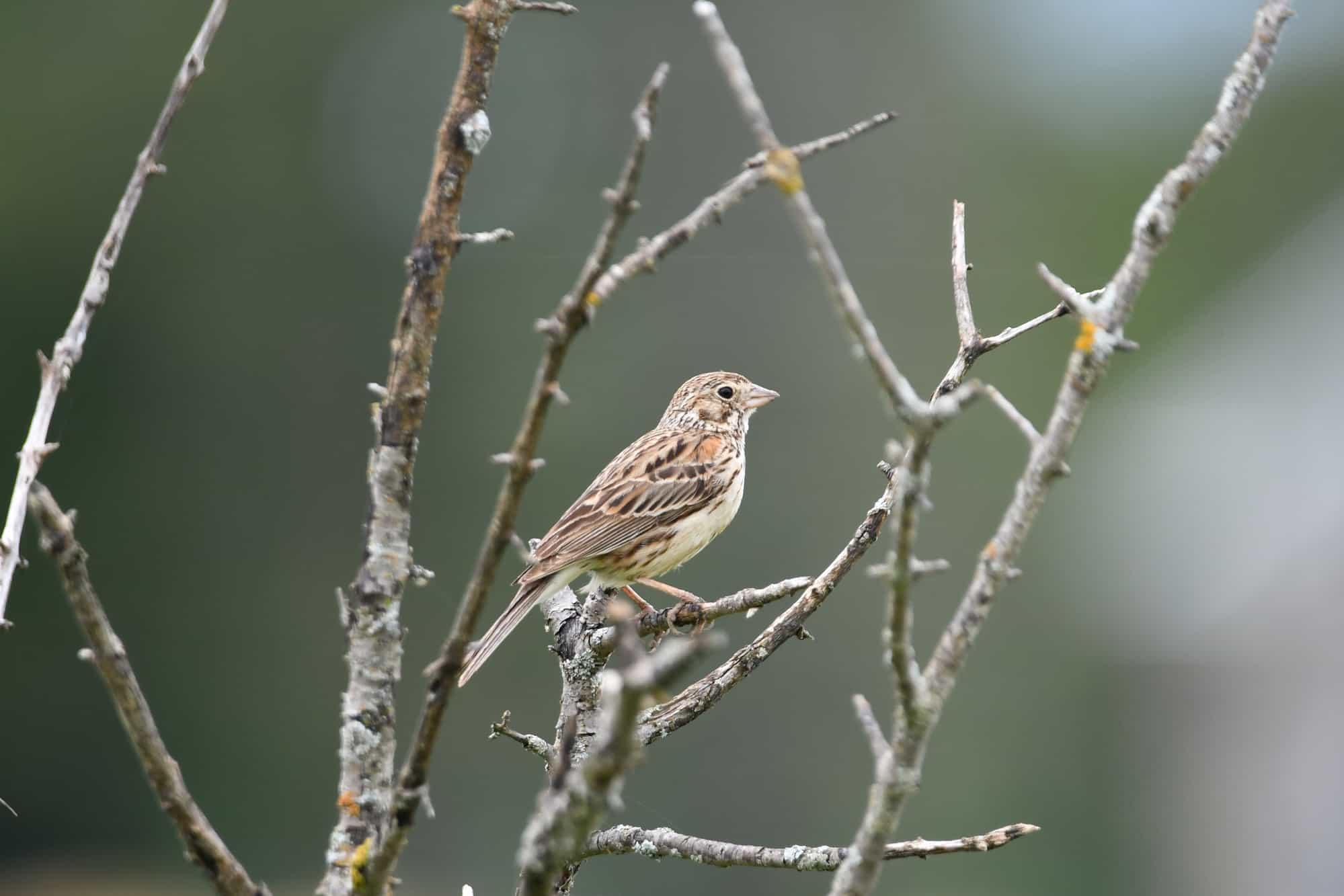
- Pooecetes gramineus
- ORDER: Passeriformes
- FAMILY: Passerellidae
- Length: 5.1-6.3 in (13-16 cm)
- Weight: 0.7-1.0 oz (20-28 g)
- Wingspan: 9.4 in (24 cm)
The Vesper Sparrow earned its name from the pretty, melodic song it sings at dusk. In some Christian traditions, “vespers” is the name for a sundown prayer service.
Vesper Sparrows are the largest sparrows in North America. They are mostly light brown with dark brown patches and streakings over their entire body. They have white eyerings.
They migrate through most of Kansas in the spring and fall, although the very northeastern and southwestern corners of the state typically have some nesting residents. In those areas, they nest on the ground, tucked into tall grasses near a fallen tree, branch, or log.
Enjoy Spotting Sparrows in Kansas!
There are always interesting sparrows to find in Kansas. As you can see from our list, it doesn’t really matter when or where you are in Kansas – there are going to be some sparrows nearby!
Whether you live in the state or are just visiting, spotting and identifying these 25 kinds of sparrows can be a fun challenge. Make sure to take good notes and pay attention to the interesting behaviors and appearances of the many different sparrows here in Kansas.

